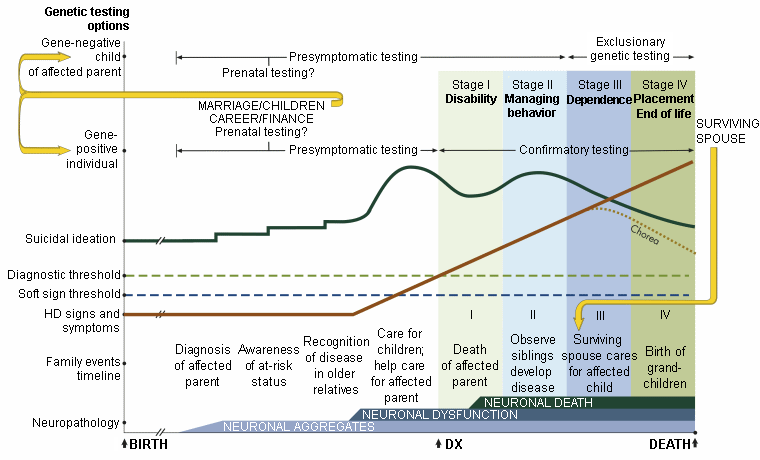Prognosis
Although patients are born with the pathogenic expanded allele, typically patients are “diagnosed” with Huntington disease when they have developed sufficient motor signs and symptoms consistent with Huntington disease. The duration of disease is approximately 20 years from time of diagnosis to time of death.[6][119] The sequential evolution of events and ultimately the hereditary nature of Huntington disease, from the perspective of a child born to an affected parent, can be depicted pictorially. Events within an affected family may occur in different sequences for different individuals.
[Figure caption and citation for the preceding image starts]: Life cycle in Huntington disease (HD)Walker FO. Huntington's disease. Lancet 2007 Jan 20;369(9557):218-28. Used with permission [Citation ends].
Although currently there are no effective disease-modifying therapies for Huntington disease, many of the symptoms are treatable. Depression should improve with therapy. Dose reduction or tapering may be appropriate after sustained improvement is seen, although a low threshold should exist for reintroducing therapy in view of the ongoing organic cause (Huntington disease) of the depression. Many people with Huntington disease stay on antidepressants for the rest of their lives once treatment has been commenced. Chorea may lessen in severity in some patients with disease progression and, as such, occasional dose reductions in antichoreic therapy are warranted to see whether lower doses are effective or still needed. Behavioral problems may lessen or fluctuate as cognitive impairment worsens. Other symptoms of Huntington disease (e.g., dysphagia, dysarthria, impaired gait, cognitive dysfunction, and incoordination) are progressive.
Use of this content is subject to our disclaimer